Teaching your dog to greet guests calmly is an essential skill that can make a world of difference in their behavior. Whether it’s at home or out in public, having a dog that greets politely can lead to more enjoyable and stress-free interactions for everyone involved. In this article, I will share effective techniques and training tips to help you teach your dog to greet calmly and politely.
Key Takeaways:
- Properly greeting guests is important for your dog’s behavior and their safety.
- Teaching calm greetings is beneficial both at home and in public settings.
- There are various training methods you can use to teach your dog to greet calmly.
- Reinforcing the “sit” behavior and using a “Say Please Program” can help promote calm greetings.
- Managing greeting situations and avoiding non-consensual dog-dog greetings are crucial for safety.
The Importance of Teaching Calm Greetings
Teaching your dog to greet guests calmly is not just a matter of etiquette; it has several important benefits. First and foremost, teaching calm greetings helps prevent damage that can occur from excited dog greetings. When dogs jump up on people, they can unintentionally scratch or rip clothing, causing embarrassment and potentially costly repairs. Additionally, an enthusiastic greeting can also result in accidental bumps or knocks, especially for small children or elderly individuals. By teaching your dog to greet calmly, you can avoid these mishaps and create a more enjoyable and stress-free environment for both your guests and your dog.
Furthermore, training your dog to greet calmly helps build good manners and reinforces positive behavior. A well-behaved dog is more likely to receive attention and be welcomed in social situations. People are naturally drawn to dogs that are polite and well-mannered, and by teaching your dog to greet calmly, you are increasing their chances of receiving love and affection from others.
Finally, teaching calm greetings goes beyond just your dog’s behavior. It also involves educating visitors on proper greetings and not encouraging wild or overexcited behavior. By setting clear rules and expectations for both your dog and your guests, you can ensure that greetings are calm, controlled, and enjoyable for everyone involved.

The Benefits of Training Dog Greetings
There are numerous benefits to training your dog to greet calmly. Not only does it prevent potential damage and promote good manners, but it also fosters positive social interactions and reinforces desired behavior. By taking the time to teach your dog proper greetings, you are investing in their overall development and well-being.
By teaching your dog to greet calmly, you are also setting them up for success in other areas of their life. Dogs who have learned impulse control and good manners are more likely to excel in obedience training, enjoy more freedom in public spaces, and have stronger bonds with their owners. Additionally, by promoting calm greetings, you are helping to create a positive image of dogs in general, making them more welcome in a variety of environments and situations.
In conclusion, teaching your dog to greet calmly is not only important for preventing damage and building good manners but also for fostering positive social interactions and setting your dog up for success in various aspects of their life. It is a valuable investment in your dog’s well-being and happiness as well as the overall perception of dogs in society.
Training Methods for Calm Greetings
When it comes to teaching calm greetings to your dog, there are several effective training methods you can utilize. These techniques will help your dog learn to greet guests and other dogs in a calm and controlled manner. By incorporating these methods into your training routine, you can ensure that your dog’s greetings are polite and well-mannered.
Tether Training
Tether training is a valuable method for teaching calm greetings. Using a leash or tether, you can control your dog’s movement and prevent jumping or excessive excitement when greeting guests. Start by having your dog on a leash and rewarding them for sitting calmly when someone approaches. Gradually increase the level of distraction and reinforce the sitting behavior consistently. This method helps your dog understand that calm greetings are rewarded and expected.
Focus and Redirect
Another effective technique is to teach your dog to focus on you and redirect their attention during greetings. Use treats or toys to get your dog’s attention and reward them for maintaining eye contact and calm behavior. Practice this technique during training sessions and gradually introduce it during real-life greeting situations. By redirecting your dog’s focus away from excitement and onto you, you can reinforce calm greetings.
Positive Reinforcement
Positive reinforcement is a key aspect of training calm greetings. Reward your dog with treats, praise, and affection when they exhibit calm behavior during greetings. Use a consistent command, such as “calm” or “gentle,” to signal the desired behavior. By consistently rewarding and reinforcing calm greetings, your dog will learn to associate positive outcomes with calm behavior and will be more likely to greet guests in a calm manner.
| Training Method | Description |
|---|---|
| Tether Training | Using a leash or tether to control your dog’s movement during greetings, rewarding them for sitting calmly. |
| Focus and Redirect | Teaching your dog to focus on you and redirect their attention away from excitement during greetings. |
| Positive Reinforcement | Rewarding your dog with treats, praise, and affection for exhibiting calm behavior during greetings. |

By implementing these training methods, you can ensure that your dog learns to greet guests and other dogs in a calm and well-mannered manner. Try to be patient and consistent in your training efforts, and over time, your dog will become proficient in greeting calmly.
Teaching the “Move with Me” Cue
To teach your dog to greet other dogs calmly on leash, one effective cue you can use is the “move with me” cue. This cue involves walking forward and then turning in the opposite direction, encouraging your dog to turn with you. It can also be useful in training calm greetings with humans.
Start by walking forward with your dog on a loose leash. When you reach a point where you want to turn, give a verbal cue such as “turn” or “move with me” and start to turn your body in the opposite direction. At the same time, use a treat or toy to guide your dog’s attention and encourage them to turn with you.
Repeat this exercise in different locations, gradually reducing the amount of verbal and visual cues you use. Eventually, your dog should be able to turn with you without the need for any cues or guidance. Try to reward your dog for their cooperation and practice the “move with me” cue regularly to reinforce the behavior.
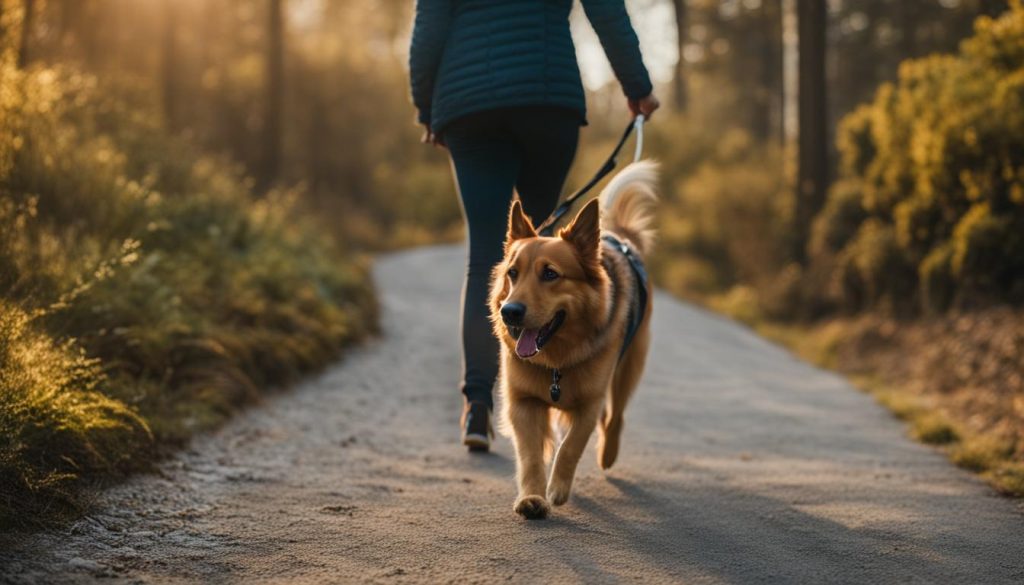
Benefits of Teaching the “Move with Me” Cue
Teaching your dog the “move with me” cue has several benefits. First, it helps your dog learn impulse control and follow your lead, which is important for polite greetings. By teaching your dog to turn with you, you can redirect their attention away from potential distractions and towards you.
It also enhances your dog’s walking skills on leash, as they learn to move in sync with you. This can make walks more enjoyable and reduce pulling or other leash-related issues. Additionally, the “move with me” cue can improve communication between you and your dog, strengthening your bond and trust.
| Benefits of the “Move with Me” Cue |
|---|
| Teaches impulse control |
| Redirects attention during greetings |
| Improves walking skills on leash |
| Strengthens communication and bond |
Using a “Say Please Program”
A “Say Please Program” is a highly effective method for teaching dogs to greet politely and calmly. This program involves reinforcing the behavior of sitting when approached by someone, which encourages your dog to offer a calm greeting. By rewarding sitting behavior, you can establish a positive association with polite greetings and create a well-mannered dog.
To implement the “Say Please Program,” you can follow these steps:
- Step 1: Start by teaching your dog the “sit” cue using positive reinforcement. Reward your dog with treats, praise, or a favorite toy when they sit on command.
- Step 2: Practice the sit command in various situations, such as during mealtime or before leash walks. Consistency is key to reinforce the behavior.
- Step 3: Encourage your dog to sit when approached by someone. This can be done by having a family member or friend approach slowly while you give the cue to sit. Reward your dog for complying with treats or praise.
- Step 4: Gradually increase the difficulty by having strangers approach or practicing in busier environments. Try to always reward calm and polite greetings.
By consistently practicing the “Say Please Program,” you can teach your dog to sit politely and calmly when greeting others, reinforcing good manners and promoting positive interactions.
“The ‘Say Please Program’ is a fantastic way to teach dogs to offer polite and calm greetings. By reinforcing sitting behavior, we create a positive association with calm greetings, promoting good manners and positive interactions.” – Professional Dog Trainer
| Benefits of a “Say Please Program” | How to implement the program |
|---|---|
| 1. Reinforces sitting behavior | 1. Teach the “sit” cue using positive reinforcement. |
| 2. Teaches dogs to sit politely | 2. Practice the sit command in various situations. |
| 3. Rewards calm greetings | 3. Encourage your dog to sit when approached by someone. |
| 4. Promotes positive interactions | 4. Gradually increase the difficulty and practice in different environments. |

Managing Greeting Situations
When it comes to managing dog greeting situations, controlling the environment and preventing reinforcement for jumping are key. By implementing effective leash management techniques, you can ensure that your dog greets guests and other dogs in a calm and controlled manner.
One important aspect of managing greeting situations is keeping your dog on a leash when greeting people. This allows you to have better control over your dog’s behavior and prevents them from jumping or engaging in other unwanted behaviors. Additionally, by providing clear instructions to visitors on how to interact with your dog, you can reinforce polite greetings and discourage any behaviors that may lead to excitement or jumping.
“Proper leash management is crucial in managing greeting situations. By keeping your dog on a leash, you have better control over their behavior and can prevent jumping or other unwanted behaviors.”
Tethering or using a baby gate can also be helpful in managing greeting situations, especially during guest arrivals. By keeping your dog away from the door, you can prevent them from jumping on guests or becoming overly excited. Providing a designated area for your dog to wait, along with a basket of toys or treats, can redirect their attention and reinforce sitting behavior during greetings.
Leash Management Tips
- Always keep a firm grip on the leash, maintaining a short distance between you and your dog.
- Use a sturdy leash and collar or harness to ensure your dog’s safety and your control over their movements.
- Guide your dog’s behavior with gentle and consistent leash cues, encouraging them to stay calm and focused.
- Be aware of your surroundings and anticipate potential triggers or distractions that may cause your dog to become excited.
By effectively managing greeting situations and implementing leash management techniques, you can create a calm and controlled environment for your dog to greet guests and other dogs. Consistency and clear communication with both your dog and visitors are key to reinforcing polite and well-mannered greetings.
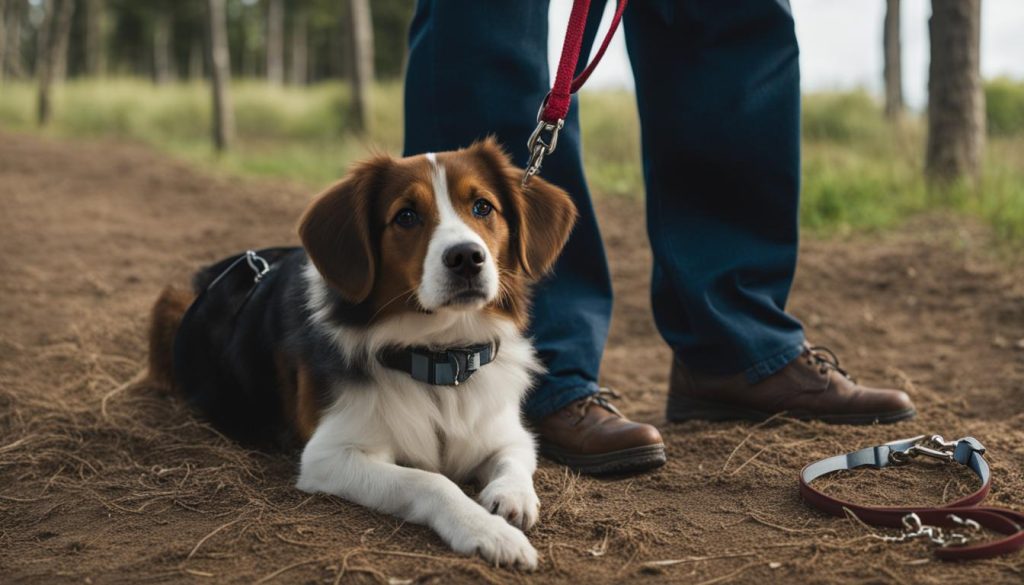
Reinforcing the Sit Behavior
In order to teach dogs to greet calmly, reinforcing the sit behavior is essential. By consistently rewarding your dog for sitting during greetings, you can encourage them to adopt a calm and polite approach. You should reinforce sitting behavior in various situations, such as during mealtime, leash walks, and interactions with visitors. The more opportunities you provide for your dog to practice and be rewarded for sitting, the more likely they will offer a sit when approached by someone.
When reinforcing the sit behavior, it is good practice to use positive reinforcement techniques. This involves providing rewards, such as treats or praise, immediately after your dog sits. By associating sitting with positive outcomes, your dog will be motivated to repeat the behavior. Additionally, using a consistent cue, such as “sit,” helps to reinforce the desired behavior and strengthens the sit cue over time.
Consistency is key when reinforcing the sit behavior. Every opportunity to reward your dog for sitting should be taken, reinforcing the behavior in a variety of contexts. By doing so, you are building a strong foundation for polite greetings and encouraging your dog to remain calm and controlled during interactions with both humans and other dogs.
| Benefits of Reinforcing the Sit Behavior: |
|---|
| 1. Encourages calm and polite greetings. |
| 2. Strengthens the sit cue and promotes consistent behavior. |
| 3. Builds a positive association with sitting. |
| 4. Motivates your dog to repeat the desired behavior. |
| 5. Reinforces the foundation for good manners and polite interactions. |
To summarize, reinforcing the sit behavior is crucial in training dogs to greet calmly. By consistently rewarding your dog for sitting and using positive reinforcement techniques, you can encourage them to offer a sit when approached by someone. This helps to create a foundation for polite greetings and promotes calm and controlled interactions.
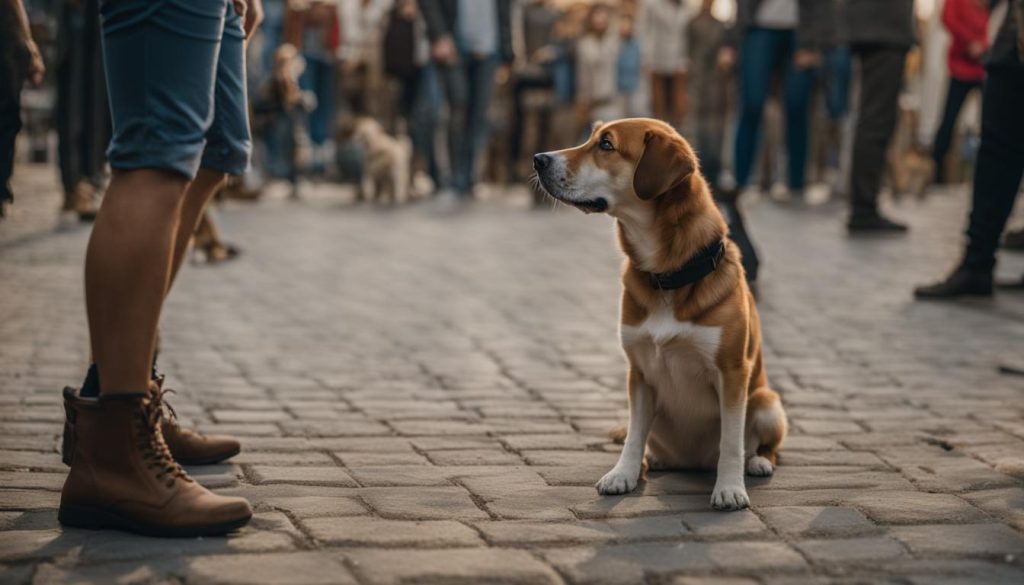
Practicing Polite Greetings
Practicing polite greetings is an essential part of training your dog to greet guests and other dogs calmly. By incorporating regular training sessions into your routine, you can help your dog develop the necessary skills and behaviors for polite greetings. Here are some key techniques to help you train your dog to approach calmly:
- Leash training: Start by practicing greetings on a leash to provide control and prevent jumping or lunging. Use treats and positive reinforcement to reward calm behavior when your dog approaches someone.
- Teaching approach cues: Train your dog to respond to specific cues, such as “let’s go say hi” or “approach,” to signal that it’s okay to approach someone. This helps your dog understand when greetings are appropriate and encourages calm behavior.
“Training sessions for greetings help reinforce the desired behavior and provide opportunities for socialization. Consistency and positive reinforcement are key to success.”
During training sessions, stay patient and consistent. Gradually increase the level of difficulty by practicing greetings in different environments and with various distractions. Try to always reward and praise your dog for calm and polite greetings. With practice and repetition, your dog will learn to approach others calmly and become a well-mannered companion.

Example Training Schedule
| Training Sessions per Week | Description |
|---|---|
| 3-4 | Practice on-leash greetings with family members and close friends in a controlled environment. |
| 2-3 | Gradually increase the level of difficulty by practicing greetings with unfamiliar people in different locations. |
| 1-2 | Attend supervised group training sessions to provide opportunities for socialization and reinforce proper greeting behavior. |
Consistency is key when training your dog to greet others politely. Make sure to set aside dedicated time for training sessions and maintain a positive and patient attitude. With time and practice, your dog will become confident in approaching others calmly and make a positive impression on guests and other dogs.
Avoiding Non-Consensual Dog-Dog Greetings
When it comes to dog greetings, consider the concept of consent. Not all dogs enjoy interacting with other dogs, and forcing them into greetings can lead to reactive behavior and negative experiences. To prevent such situations, please set boundaries and avoid non-consensual dog-dog greetings.
One effective way to prevent reactive behavior during greetings is to avoid allowing dogs to meet on leash. When dogs are restrained by a leash, it can create tension and trigger defensive or aggressive responses. Instead, consider arranging meetings in safely enclosed areas where leashes can be removed and proper introductions can take place. This allows dogs to approach each other on their terms and reduces the likelihood of negative reactions.
Setting boundaries is also essential when it comes to dog-dog greetings. Not all dogs are social butterflies, and some may prefer their personal space. By respecting their boundaries and not forcing interactions, you promote a safer and more positive environment for both dogs involved. Pay attention to signs of discomfort or stress, such as avoiding eye contact, growling, or trying to move away, and intervene if necessary to prevent any escalation in behavior.
| Benefits of Avoiding Non-Consensual Dog-Dog Greetings | Tips for Avoiding Non-Consensual Dog-Dog Greetings |
|---|---|
| – Prevention of reactive behavior | – Arrange off-leash meetings in safely enclosed areas |
| – Reduction of stress and negative experiences | – Respect boundaries and signs of discomfort |
| – Promotion of positive interactions and socialization | – Intervene if necessary to prevent escalation |
Avoiding non-consensual dog-dog greetings is crucial for maintaining a harmonious and safe environment for our furry friends. By respecting their preferences and setting boundaries, we can promote positive interactions, reduce stress, and prevent reactive behavior. To put it simply, every dog is unique, and prioritize their well-being and comfort during greetings.
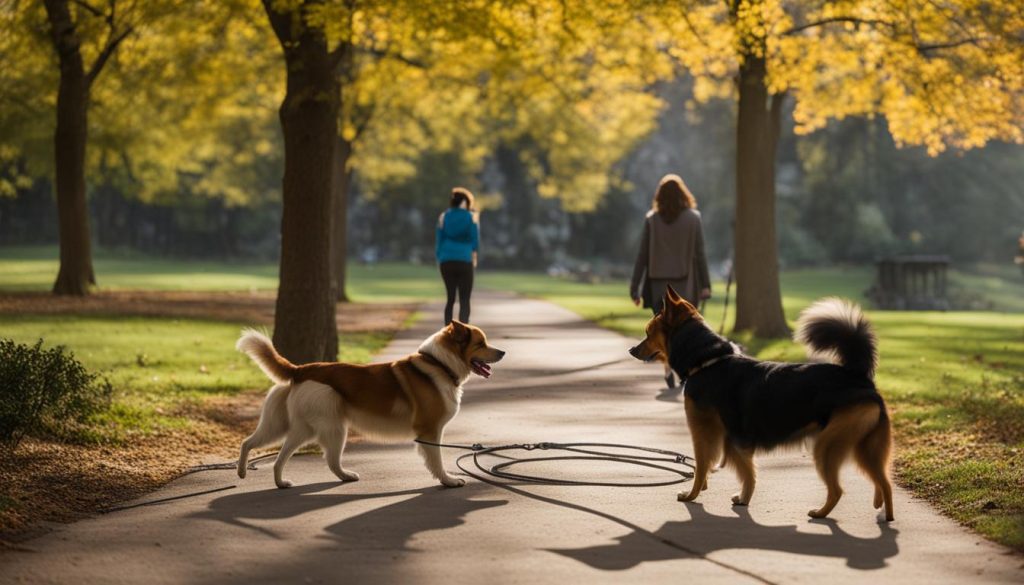
Guidelines for Greeting Other Dogs Safely
When it comes to greeting other dogs, follow guidelines to ensure a safe and positive interaction. Introducing dogs properly sets the foundation for a successful meeting and helps prevent potential conflicts. Here are some guidelines and tips for safe dog greetings:
1. Introduce dogs on-leash
When introducing dogs for the first time, it’s best to keep them on-leash. This allows you to maintain control and prevent any potential issues. Start by walking both dogs parallel to each other while maintaining a safe distance. Gradually decrease the distance and observe their body language for signs of stress or tension.
2. Watch for compatibility cues
Before allowing off-leash interactions, ensure that both dogs are comfortable and compatible. Look for signs of interest and positive body language, such as wagging tails and relaxed postures. If either dog shows signs of aggression or fear, separate them and seek professional guidance.
3. Use on-leash greeting tips
During the initial greeting, follow on-leash greeting tips to ensure a smooth interaction. Keep the leashes loose to allow natural movement and avoid tension. Avoid face-to-face introductions and instead allow the dogs to approach each other from the side, which is less confrontational. Keep greetings short and positive, and monitor the dogs’ behavior for any signs of discomfort.
| Signs of a Positive Greeting | Signs of Discomfort or Aggression |
|---|---|
|
|
Quote: “Properly introducing dogs and allowing them to greet each other in a controlled and positive manner is essential for their social development.” – Professional Dog Trainer
To put it simply, each dog is unique, and some may be more social or tolerant than others. Always prioritize safety and be prepared to intervene if necessary. If you’re unsure about the compatibility between dogs or need assistance with introductions, consult a professional dog trainer for guidance.

With these guidelines and precautions in mind, you can create opportunities for safe and enjoyable dog greetings, fostering positive social interactions and preventing potential conflicts.
Importance of Basic Good Manners Training
When it comes to training our dogs, one aspect that cannot be overlooked is teaching them basic good manners. The benefits of this type of training are manifold, extending beyond the realm of greetings and into various areas of a dog’s life.
One of the key advantages of basic good manners training is the ability to generalize these behaviors to new environments. By teaching dogs how to behave politely in a variety of situations, they become more adaptable and better equipped to handle different social settings. This is particularly important when it comes to greetings, as dogs need to understand how to appropriately interact with both humans and other dogs.
Another important aspect of basic good manners training is coaching dogs for appropriate behavior. By teaching them the necessary skills and reinforcing positive behaviors, we can help our dogs navigate social situations with confidence and ease. This not only ensures their safety but also enhances their overall well-being and quality of life.
| Benefits of Basic Good Manners Training: |
|---|
| Generalization of behaviors to new environments |
| Improved adaptability in social settings |
| Enhanced safety and well-being |
| Promotion of confident and polite behavior |
In conclusion, basic good manners training is of utmost importance when it comes to teaching our dogs how to greet calmly. Through this training, we can help them generalize their behaviors, coach them for appropriate interactions, and ultimately create well-mannered and polite pets. So let’s prioritize their education and invest the time and effort into training our dogs to be courteous members of society.
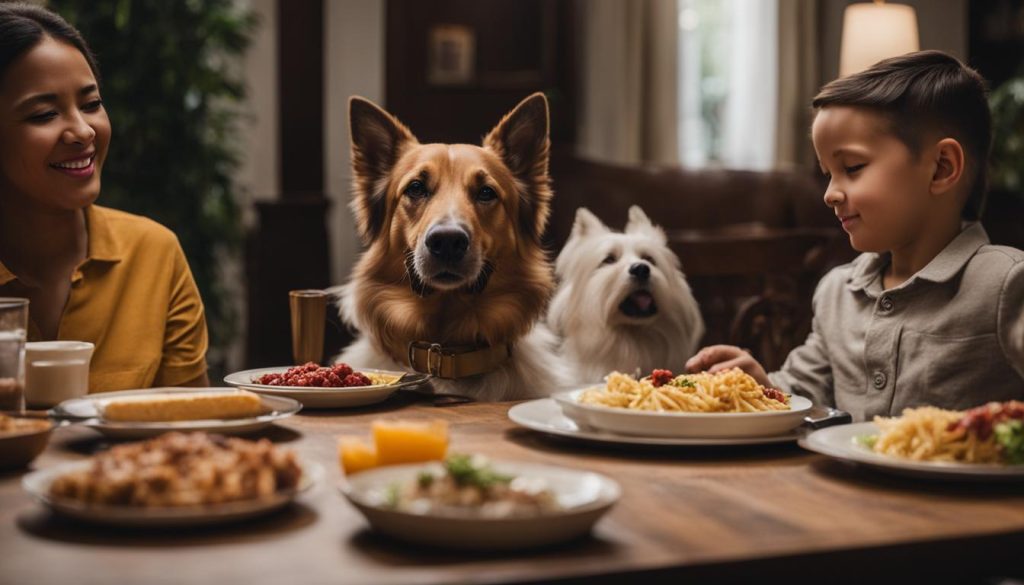
Final Thoughts
In conclusion, teaching your dog to greet calmly is crucial for promoting good manners and avoiding unwanted behavior. By following the training methods and tips provided in this article, you can establish a foundation for polite greetings both at home and in public.
Consistency is key when training your dog to greet calmly. Consistently reinforce sitting behavior and reward your dog for calm and polite greetings. Use positive reinforcement techniques, such as treats and praise, to encourage the desired behavior.
Try to manage greeting situations effectively by controlling the environment and providing clear instructions to visitors. Keeping your dog on a leash and redirecting their attention with toys or treats can help prevent reinforcement for jumping or other undesirable behaviors.
Lastly, you should prioritize safety during greetings. Avoid non-consensual dog-dog greetings on a leash and introduce dogs in safely enclosed areas without leashes when appropriate. Always ensure compatibility between dogs before allowing off-leash interactions.
FAQ
How can I teach my dog to greet guests calmly?
There are several methods you can use to teach your dog to greet guests calmly. You can give your dog a special place to sit or lie calmly while they wait for visitors. You can also teach your dog to shake hands with guests before they enter. Consistency, positive reinforcement, and having treats and a designated greeting spot are important for training.
Why is teaching calm greetings important?
Teaching your dog to greet guests calmly is important for preventing damage caused by an excited dog, building good manners, and allowing your dog to receive more attention when you have company. You might want to let visitors know the rules and not encourage your dog to jump or greet in a wild fashion.
What training methods can I use to teach calm greetings?
You can use methods such as teaching your dog a “move with me” cue, using a “Say Please Program” to reinforce sitting behavior, and managing greeting situations by keeping your dog on a leash and providing clear instructions to visitors. Consistency and positive reinforcement are key in all training methods.
How can I teach my dog to greet other dogs calmly on leash?
You can start by teaching your dog a cue called “move with me,” which involves walking forward and turning in the opposite direction, encouraging your dog to turn with you. This cue can also be useful in training calm greetings with humans. You should introduce dogs in safely enclosed areas where leashes can be removed and proper introductions can take place.
How can I reinforce the sit behavior for calm greetings?
Reinforcing the sit behavior is crucial in teaching dogs to greet calmly. You can reinforce sitting behavior during mealtime, leash walks, and interactions with visitors. Every opportunity to reinforce your dog for sitting should be taken to increase the chances that they will offer a sit when approached by someone.
How can I practice polite greetings with my dog?
You can use a tether to control your dog’s movement and repeatedly approach and reward them for sitting. Consistent practice of polite greetings helps reinforce calm behavior. Family members and friends can also participate in the training. If your dog tries to jump up, simply say “Oops!” in a cheerful tone, turn your back, and step away.
How should I manage greeting situations to prevent jumping?
Managing greeting situations is important to prevent reinforcement for jumping behavior. Always keep your dog on a leash when greeting people and provide clear instructions to visitors on how to interact with your dog. Tethering or using a baby gate can help keep your dog away from the door during guest arrivals. Having toys or treats at the door can redirect your dog’s attention and reinforce sitting behavior.
How can I avoid non-consensual dog-dog greetings?
You should avoid allowing dogs to meet on leash, as it can create problems and make dogs more prone to pulling and barking. It is advisable to only allow dogs to interact in safely enclosed areas where leashes can be removed and proper introductions can take place.
What are the guidelines for greeting other dogs safely?
When greeting other dogs, you should teach your dog to approach calmly on a loose leash. Introduce dogs in safely enclosed areas where leashes can be removed, and ensure compatibility before allowing off-leash interactions. Following these guidelines can prevent frustration and aggression during dog greetings.
How important is basic good manners training for calm greetings?
Basic good manners training plays a vital role in teaching dogs to greet calmly. Enrolling in a well-run force-free group class is recommended, as it allows dogs to generalize good manners to new environments and distractions. Instructors can provide valuable feedback on both the dog’s behavior and the owner’s skills, ensuring proper training and coaching for appropriate greetings and behavior around other dogs and humans.






